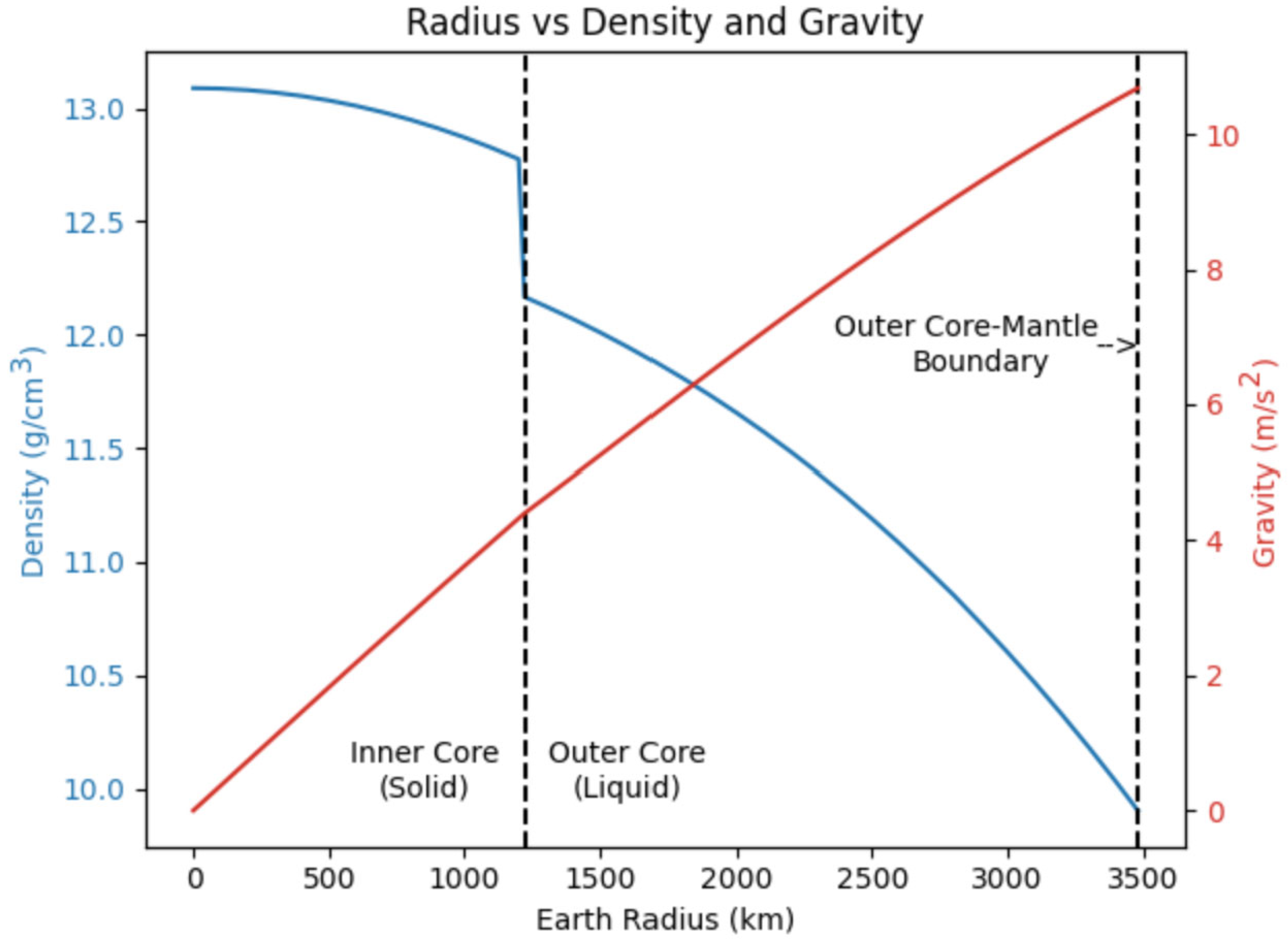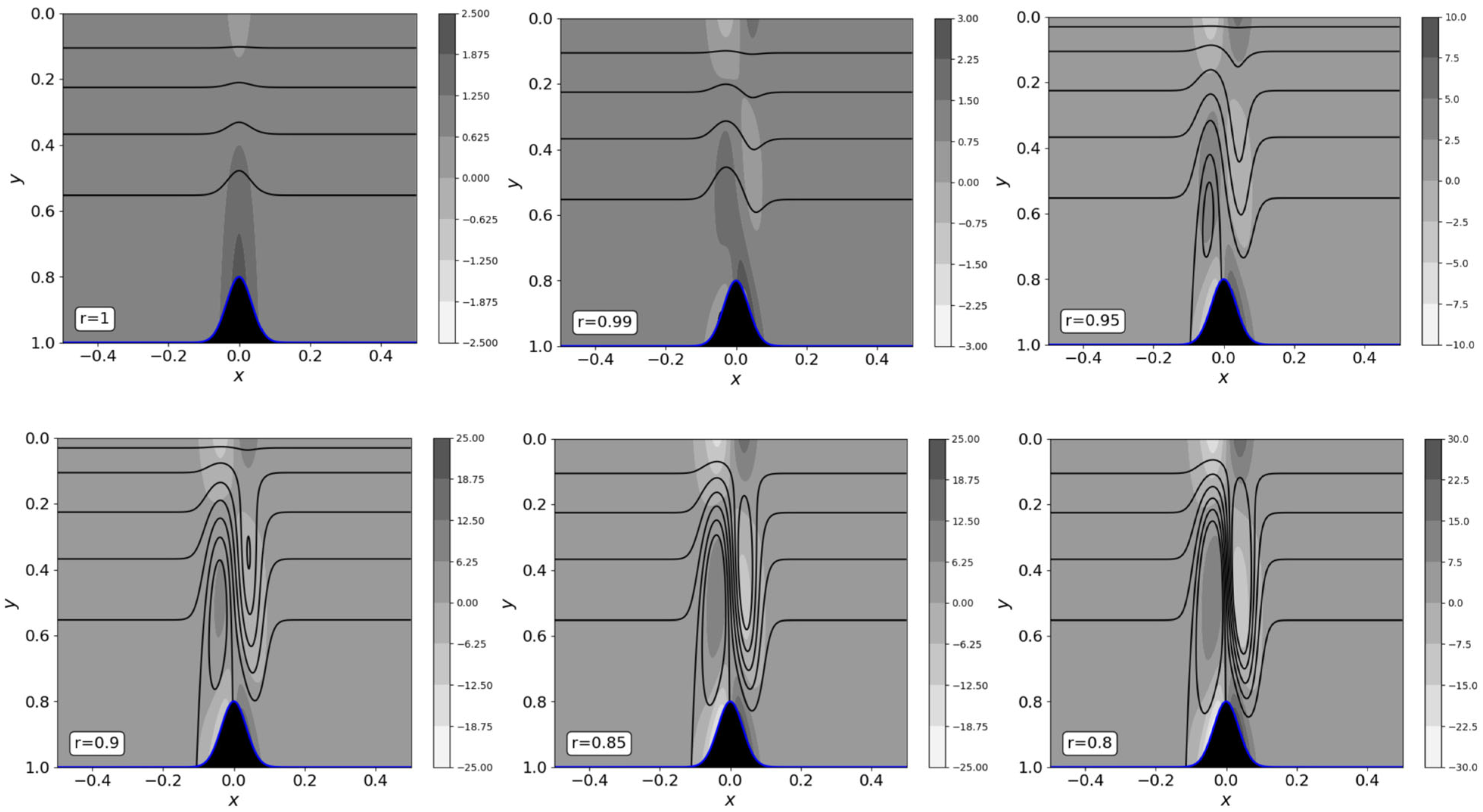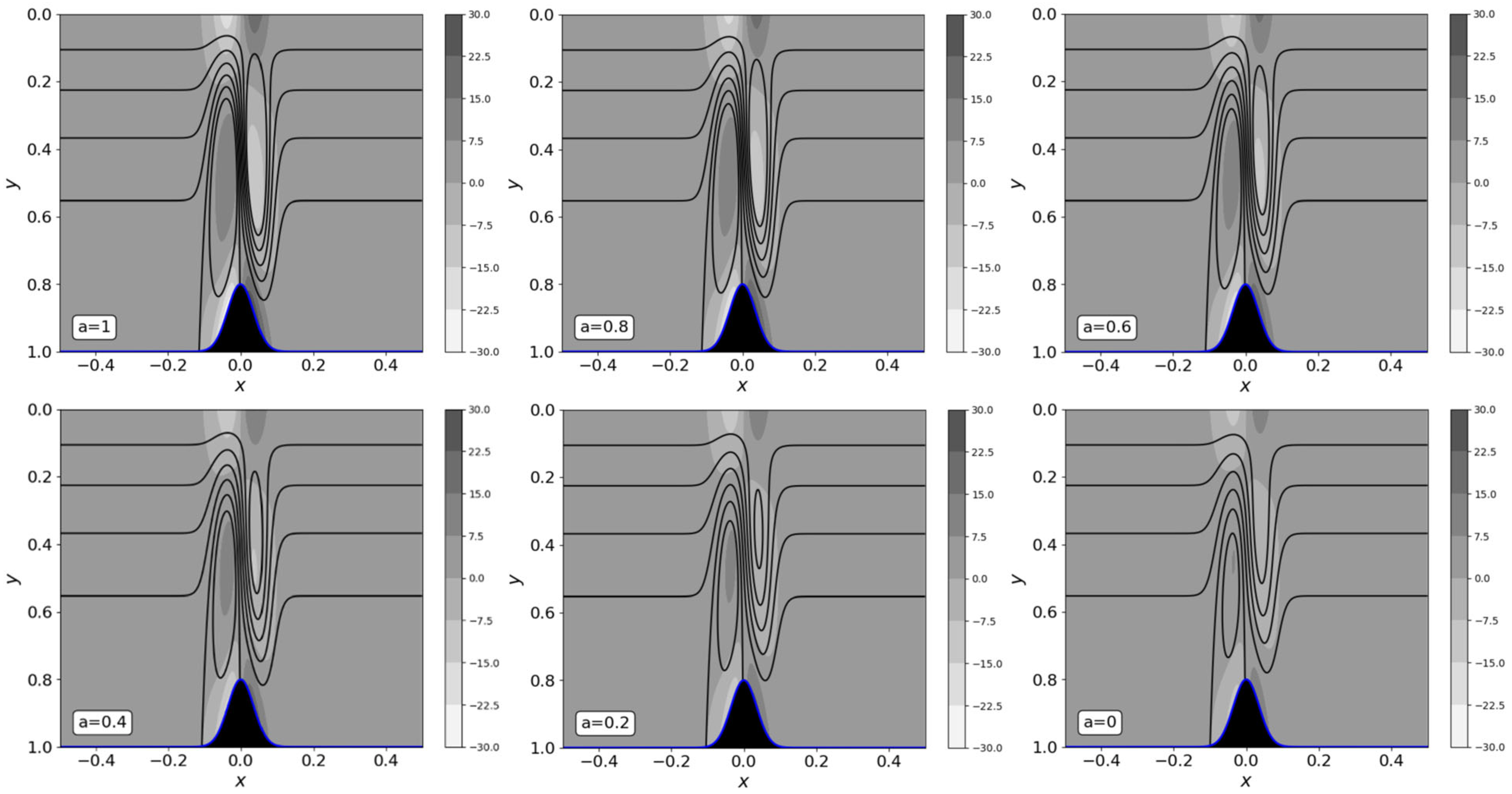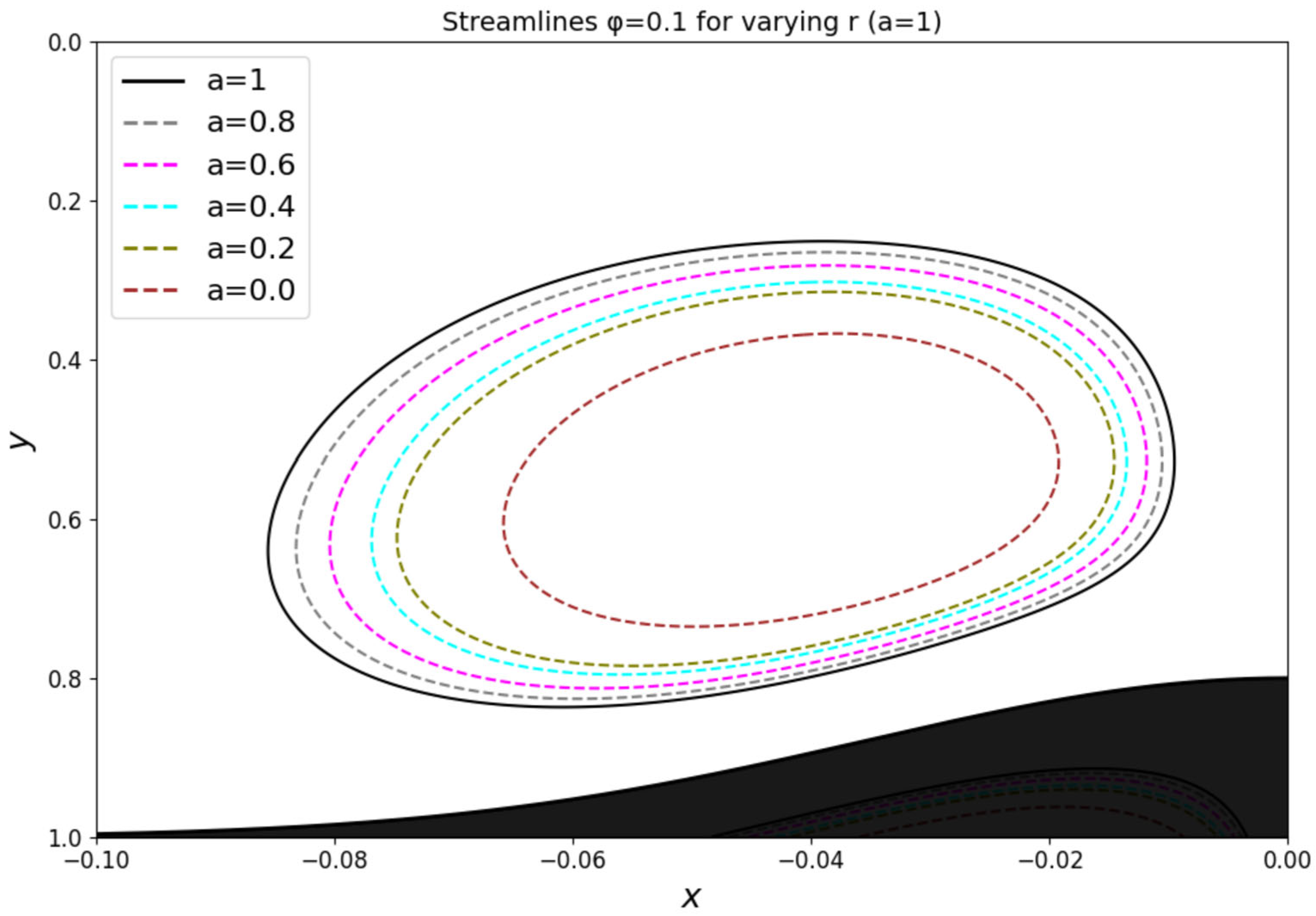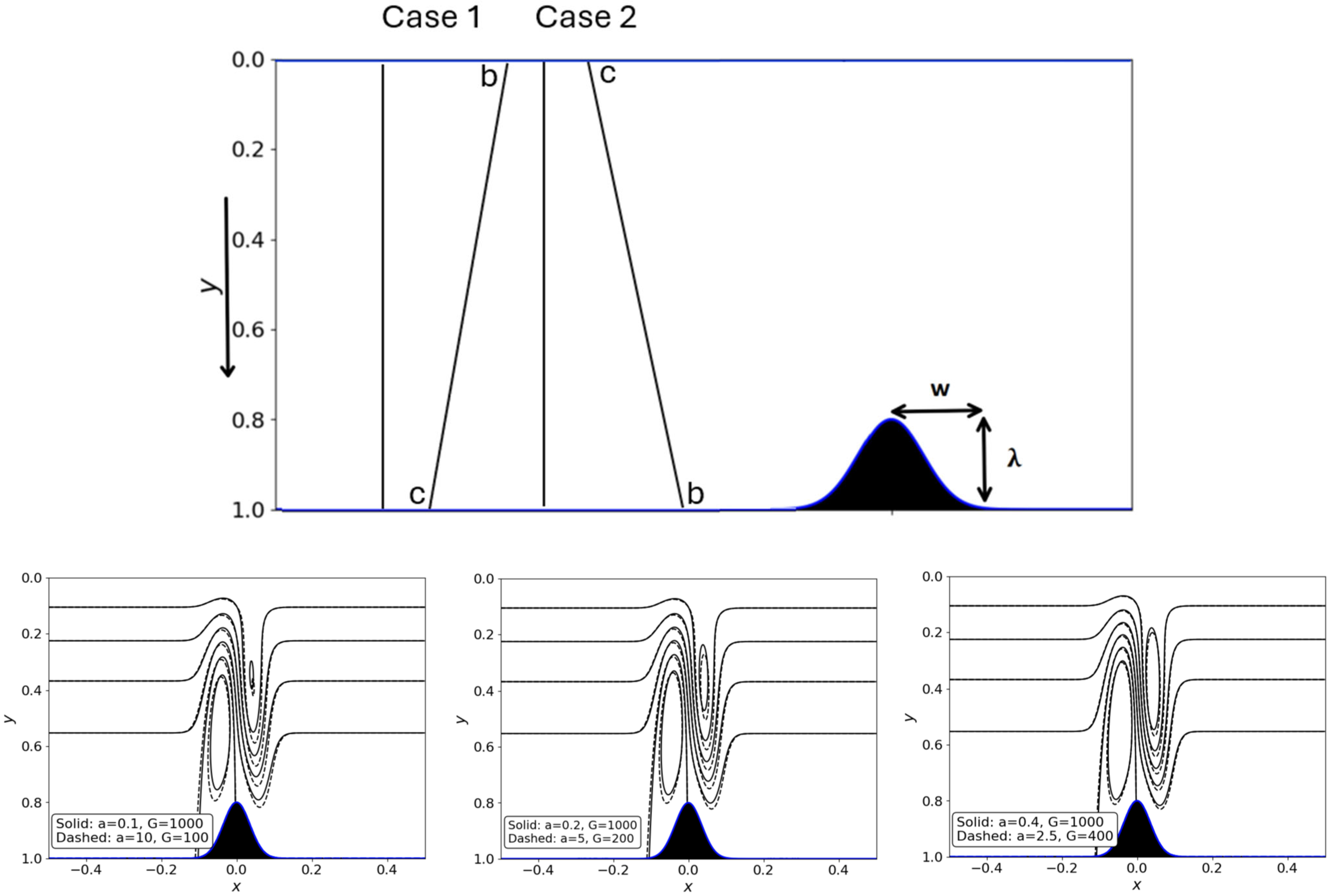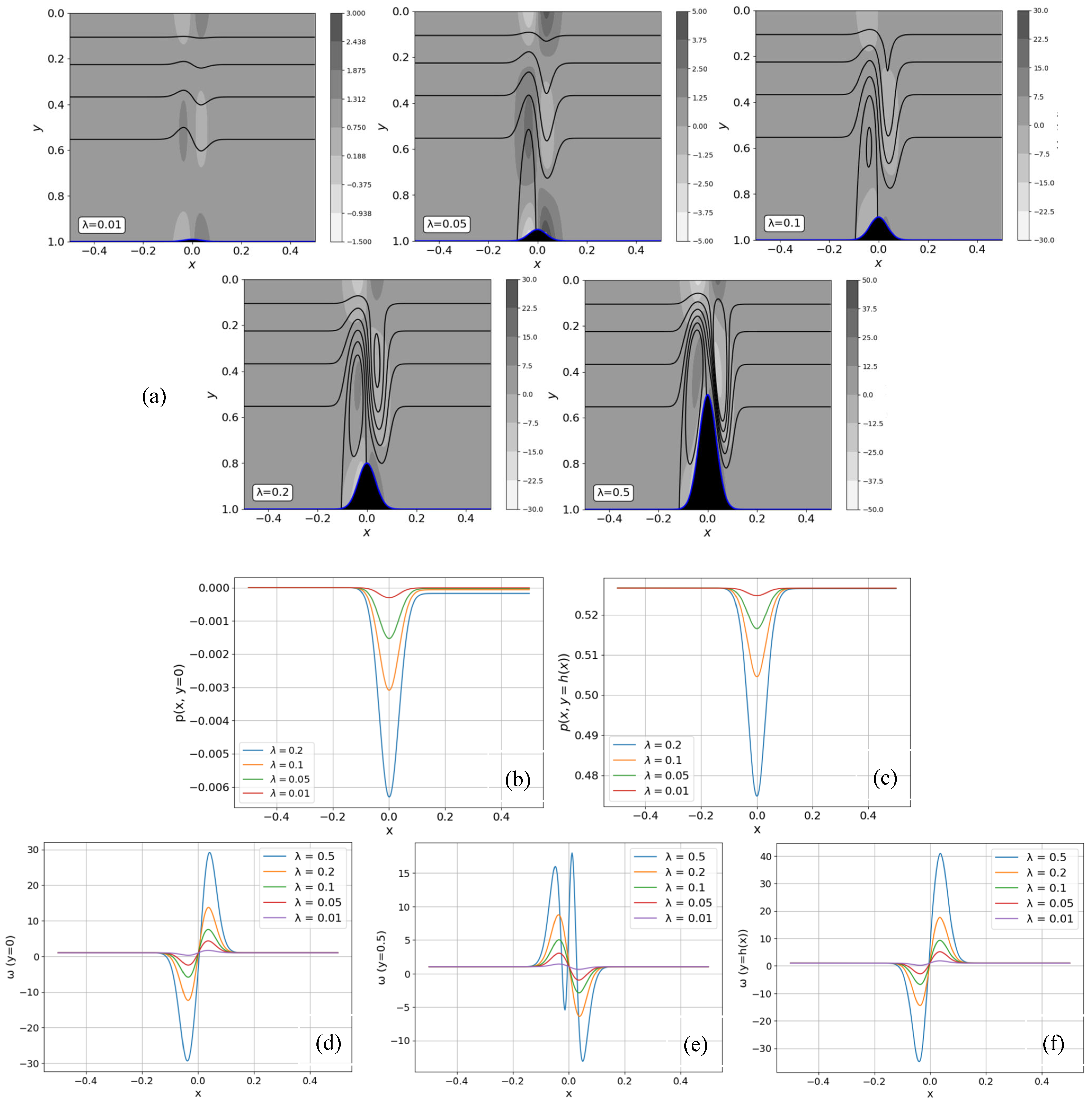4.1. In the Absence of Density and Gravity Stratifications
The flow in the absence of density and gravity stratification is well established and, therefore, serves as a reference limit that is useful when interpreting complex physics in the presence of stratification. Thus, setting r = a = 1, the flow field is reduced to the following:
Here, G is the only parameter in the problem. In this case, the streamwise pressure gradient is only a function of x, and the velocity component, u, cannot display a change in concavity along the y direction, allowing no possibility of vortex formation. In other words, since for any x, the pressure gradient from Equation (36) is , which is independent of y for any x, thus driving the flow forward and enhancing the plate movement.
The flow fields for constant density and gravity are shown in
Figure 3. The obstacle shape in Equation (1) corresponds to
. The streamlines and vorticity contours in
Figure 3a show the expected gradual deviation from parallel flow near the top translating plate to the distorted flow near the bottom boundary where the obstacle is located.
Figure 3b,c confirm the symmetric
and antisymmetric
velocity profiles as predicted by Equations (32) and (33), respectively. For
, the flow remains Couette and unaffected by the obstacle. Closer to the origin, the flow displays the Couette–Poiseuille characteristic typically predicted by the Reynolds equation for a homogeneous fluid. We note that the v component may appear to be of the same order of magnitude as u (order one in this case), but the true magnitude is of order
due to the scaling.
Figure 4 illustrates the pressure distribution for the flow in
Figure 3. The pressure contours in
Figure 4a reflect a decrease in pressure with x and an increase with distance from the top towards the bottom boundary. The pressure gradient is zero upstream and downstream of the obstacle (h = 1). Referring to Equations (34)–(36) and
Figure 4b, we can see that the pressure gradient in the x-direction is negative everywhere since h < 1, except along the bottom downstream of the obstacle, where
due to the variation in height of the bottom boundary. However, within the interior of the flow, adverse pressure gradients along streamlines develop in the lee of the obstacle, as shown in
Figure 3. In a uniform-density fluid, an adverse pressure gradient develops in the expanding flow, leading to deceleration; however, given the absence of stratification, flow reversal cannot occur at the bottom boundary regardless of the bottom’s topography. This is confirmed by the streamwise velocity, u, which is always positive everywhere in the flow. Given the symmetry of the obstacle, the velocity field is also symmetric, as reflected in the symmetric and antisymmetric streamwise and transverse velocity components.
4.2. The Influence of G
We examine the influence of G to investigate the range of flow regimes for fixed moderate density and gravitational stratifications given by r = a = 0.9. The overall influence of G is illustrated in
Figure 5, where the flow field and vorticity contours are depicted for 1 < G < 10,000 (
Figure 5a). The corresponding pressure distributions along the top and bottom boundaries are also shown in
Figure 5b and
Figure 5c, respectively, as well as the u and v profiles at different x positions for G = 1000 in
Figure 5d,e. It is worth mentioning that the relatively large G value in
Figure 5 may appear too large for the narrow-gap approximation to hold. However, we recall that
, reflecting the competence between the effects of inertia and gravity. Consequently, the narrow-gap approach should remain valid for large values of G, as long as Re remains moderately small (with Fr being small). Indeed, in our previous work [
24], we conducted an extensive comparison between the numerical solution of the Navier–Stokes equation and the narrow-gap results for the zero-gravity gradient. For example, a comparison for an aspect ratio of 0.1 and the cases Re = 1, Fr = 3.2 × 10
−4 (G = 100,000)), Re = 10, Fr = 3.2 × 10
−3 (G = 1000) and Re = 100, and Fr = 3.2 × 10
−2 (G = 100) led to a very significant agreement in the flow and vortex structure as well as the velocity and pressure fields. Before discussing
Figure 4 in detail, the flow may be described for moderately small G and large G ranges. For this, it is helpful to consider the small and large limits of G.
For small G, the velocity in Equation (27) is reduced to the classical profile, with no influence of stratification:
whereas the expressions of the pressure and wall shear stress are reduced to the following:
This shows, in particular, that the pressure gradient is independent of y. More importantly, and as expected, the small G limit obliterates the effects of both the density and gravitation stratifications, even when
and
. In this case, the flow field remains, as given by Equations (27)–(29). This behavior is typically reflected in
Figure 5 for G < 10. In this range, the streamlines are essentially parallel to the bottom topography near the bottom of the plate, gradually becoming horizontal closer to the top of the moving plate. There is a slight loss of symmetry in the flow field for G = O(10) and an increase in the symmetry of the pressure along the bottom topography.
On the other hand, for large values of G, assuming density stratification, the following is obtained
:
Clearly, this limit is singular since Equation (43) does not satisfy the condition at the top plate. Both the velocity components and wall shear stress are of O(G). Interestingly, Equation (44) indicates that the pressure remains at O(1). We should, therefore, expect that, as the value of G increases, the flow transitions to a different regime near the top moving plate where the velocity gradient becomes large. In this case, Equation (43) remains valid away from the top plate (in the bulk region of the flow). The boundary-layer characteristic became clearer as we examined the flow by increasing G.
In particular, we assessed the conditions for the onset of vortex motion, which is reflected by the condition for flow separation. In this regard, Equations (39)–(48) for small and large G, as well as the general Equation (30), clearly reflect the role of density and gravity stratification in causing separation and vortex motion. We observe that for G = O(100), the flow field exhibits antisymmetric standing waves across the channel, especially above the obstacle region. For a higher G value, namely when G = O(1000), the standing waves give way to vortex flow upstream of the obstacle, spanning across the channel, accompanied by a significant distortion of the standing wave downstream of the obstacle. The singularity of the velocity predicted in Equation (43) is reflected in
Figure 4, where both u and v evolve rapidly near the boundaries.
As outlined below, the vortex flow intensifies both upstream and downstream of the obstacle for more pronounced stratification.
4.3. The Effect of the Density Stratification
The effect of density stratification is assessed by examining the flow for constant gravity (a = 1) and varying the density gradient r for G = 1000. The reduced key expressions are conveniently reproduced here as follows:
Figure 6 illustrates the increasing influence of the density stratification (decreasing r from 1) on the flow field. The sequence in
Figure 6 shows that in the absence of a density gradient (r = 1), the flow field is affected by the presence of the obstacle, as suggested by (49) when r = 1. For a small density gradient (r = 0.99), internal antisymmetric gravity waves are visible, which are reminiscent of those observed in the lee of ridges by Sutherland and Aguilar [
22] in their experiments. The waves in
Figure 6 intensify in amplitude when r = 0.95, resulting in the loss of symmetry and a vortex that forms upstream of the obstacle. For a stronger density gradient (r = 0.9), the vortex is pushed down as a result of the flow distortion near the moving top plate. Simultaneously, a second vortex forms downstream of the obstacle, and a jet of fluid forms between the two vortices, resulting in a blocking flow pattern similar to that described by Long [
28,
29]. Upon further decreases in r, the figures for r = 0.85 and 0.8 indicate that the vortex structure remains essentially and qualitatively unchanged, but the vortical flow intensifies, as reflected by the tightening of the streamlines.
Further details on the flow are shown in
Figure 7, namely the distributions of pressure and shear stress along the top and bottom boundaries as well as the velocity distributions for r = 0.8. The behavior of the pressure becomes clearer when inspecting the pressure gradients from Equation (51) along both the top (
Figure 7a) and bottom (
Figure 7b) boundaries:
Clearly, for relatively large G values, the pressure gradient along the two boundaries is dominated by the term proportional to the bottom slope.
Figure 7a illustrates how the pressure transitions from a monotonically decreasing function along the top plate for a constant density fluid (r = 1) to a pressure developing a minimum that strengthens with increasing density stratification (r < 1). This change in behavior is also reflected in the pressure gradient at y = 0 from Equation (52). The presence of an adverse pressure gradient at the upper boundary, which is parallel to a streamline in the flow, allows flow separation to occur in a stratified flow, forming the vortices shown in
Figure 7c–e. The pressure along the bottom boundary in
Figure 7b shows a similar trend except that, for r = 1, the pressure still displays a minimum instead of the monotonically decreasing trend reported in
Figure 4. Interestingly, this behavior is exhibited regardless of the G value.
The vorticity or wall shear stress along the top (
Figure 7c) and bottom (
Figure 7e) boundaries for a = 1 from Equation (30) is reduced to the following:
We can see that the vorticity (shear stress) is negative except along the top wall if either h < ¾ or G is relatively small 1 − r. Vorticity along the boundaries is antisymmetric for a constant-density fluid, and this symmetry is lost as r decreases from one. Symmetry is gradually regained (see the r = 0.8 curves) as the density gradient increases because of the dominance of the G(1 − r) term in Equation (53).
A closer assessment of the influence of density stratification on the vortex structure is depicted in
Figure 8, where we plotted the closed central vortex above the left-hand side of the obstacle for different values of
. As expected, the size of the vortex grew with density stratification, both in width and height. Given the fluid confinement between two rigid boundaries, the vortex cannot grow indefinitely with increasing density stratification. Indeed,
Figure 8 indicates that growth saturation occurs for r < 0.6, when the vortex occupies 70% of the fluid gap in height. The saturation is particularly obvious near the obstacle and the vertical line x = 0. The vortex size is examined further below when we discuss the interplay between the density and gravity stratifications.
4.4. Interplay Between Density and Gravity Stratifications
Gravity acts on density variation, which is, therefore, required for gravity and its stratification to affect the flow; Equations (27)–(30) confirm that for gravity stratification to significantly manifest itself in the flow, the effect of density stratification cannot be negligible. In fact, on setting r = 1, some interesting observations are worth noting here. The effect of gravity stratification vanishes entirely from Equations (27) and (28) for the velocity components, which is expected because the full Navier–Stokes equations show that, without density variation, gravity only affects the vertical pressure profile and not the velocity field. The velocity field is now independent of any parameter, namely of both G and a, while the deviation from the linear pressure profile is due to the variation in gravity. The velocity profile is parabolic and of the Poiseuille–Couette type, as seen in Equation (32). Consequently, unlike density stratification, gravity stratification alone cannot lead to vortex generation. Gravity stratification remains only influential on the pressure as Equation (29) suggests, which is reduced to the following:
The pressure is parabolic instead of cubic in y, and the gravity gradient (a < 1) diminishes its value everywhere. The streamwise pressure gradient is independent of the height, depending solely on the bottom topography. Simultaneously, the pressure does not exhibit the modulation in x reported earlier in
Figure 4 and
Figure 5. In fact, since
and h < 1, the pressure decreases monotonically regardless of obstacle shape and gravity gradient, as seen in Equation (35).
The interplay between density and gravity stratifications is further assessed in
Figure 9 and
Figure 10 by examining the flow for a constant density gradient (r = 0.8) and varying the gravity gradient. The impact of gravity variation modulates the effect of stratification on the flow. We discuss the influence of gravity stratification on the flow field by referring to
Figure 9, where the streamlines are plotted along with the vorticity contours for r = 0.8 and
. The increase in the gravity gradient diminishes the vortex intensity, which is clearly visible when a is decreased from 1 to 0 in
Figure 9. For a small gravity variation, the flow tends to compress the upstream vortex and causes the downstream vortex to open from the top, as shown for
. Upon the further increase in the gravity gradient, the upstream vortex is further compressed and distorted while the downstream vortex continues to open at the top but with little change at the bottom (0 < a < 0.4). As the gravity gradient increases, gravity becomes weaker toward the bottom of the domain, weakening the overall effect of stratification. This occurs because stratification only affects the flow field in the presence of gravity, so as gravity weakens, the effect of stratification decreases, and the vortices, which only form due to stratification, become smaller and weaker.
The relatively small change in qualitative behavior is also reflected rather starkly in
Figure 10, where the pressure and vorticity distributions are shown. Recalling Equation (29), the pressure distribution along the boundaries is as follows:
The pressure distributions in
Figure 10 indicate that the pressure at the upper boundary (
Figure 10a) remains essentially unaffected by the gravity gradient, whereas the pressure at the bottom (
Figure 10b) decreases rather significantly as
a decreases. This decrease is essentially linear with
a as the terms following the integral in Equation (56) suggest. Since G is relatively large, the pressure is essentially given by Equation (44), which shows that the pressure distribution is indeed symmetric everywhere.
This is also reflected in the vorticity from Equation (30) along the top (
Figure 10c) and bottom (
Figure 10e) boundaries:
The interplay between density and gravity stratifications was further assessed by examining the effect on the vortex shape and size.
Figure 11 depicts the dependence of the vortex shape on gravity stratification in the range
for r = 0.8. A strong gravity stratification prohibits vortex formation (the smallest vortex corresponds to a = 0).
A further quantitative assessment is reported in
Figure 12, where the height of the vortex
is plotted against r (
Figure 12a) and against a (
Figure 12b). A three-dimensional perspective is given in
Figure 12c.
Figure 12a suggests a slow decrease in the vortex size with an increasing value of r, except for r > 0.8, in which range the vortex size decreases sharply as a result of the fluid layer’s confinement between two rigid boundaries.
Figure 12b reflects a mild increase in vortex size with a diminishing gravity gradient. This increase is mildest for a heavily density-stratified layer (r = 0). Although the overall vortex height diminishes with density stratification, the growth rate as a increases. Eventually, the vortex height must tend towards zero as
.
Figure 12b suggests that the vortex tends to shrink with density stratification and disappears completely in the small
a range of r > 0.85.
The effect of gravity stratification on the vortex structure can also be illustrated by considering instances when gravity increases toward the bottom of the domain and comparing the results to the original case with gravity decreasing toward the bottom of the domain. Corresponding cases with the same vertical integral of gravity, and therefore, the same overall strength of gravity, can be considered by taking
and
for a case with gravity increasing toward the top and
and
for a case with gravity increasing toward the bottom. The relevant non-dimensional parameters in the flow are a, r, and G. In the case with decreasing gravity from dimensional values of b to c (c < b) toward the bottom of the domain, as illustrated in
Figure 13,
, while in the case of increasing gravity from c to b towards the bottom of the domain,
In the case of decreasing gravity from the dimensional values of b to c toward the bottom of the domain,
while for increasing gravity toward the bottom,
, since Re and ε are unchanged from case 1 to case 2.
Streamlines for pairs of corresponding cases with gravity increasing toward the top and bottom show that the vortex shifts toward the direction of stronger gravity, as seen in
Figure 13. This occurs due to the vortices resulting from the combined effect of gravity and stratification. For a specified, constant stratification, the vortex is stronger in the region of stronger gravity and weaker in the region of weaker gravity. The shift is small because the topographic bump is essential in generating the vortex, and its position remains the same for both cases. In the case of stronger gravity near the bottom of the domain, where the topography is located, the upstream vortex is larger than in the case of larger gravity near the top of the domain; gravity and topography both contribute to generating the vortices, so when stronger gravity occurs in the vicinity of the bump, the vortex is stronger. The downstream vortex appears to exhibit a shift without a significant change in size.
4.5. Influence of Obstacle Size
We next consider the influence of the obstacle size on the flow by examining obstacles of various heights and widths. The results correspond to G = 1000, r = 0.8, and a = 0.2.
Figure 14 depicts the influence of the obstacle amplitude for a fixed width w = 0.05. We plotted the flow field (
Figure 14a), pressure (
Figure 14b,c), and vorticity (
Figure 14c,e) along the solid boundaries for the range
. Even when the amplitude was negligibly small (λ = 0.01), the flow displayed how non-symmetric gravity waves were weakened in amplitude with increasing distance from the obstacle. As the obstacle height increased (λ = 0.05), the wave amplitude increased with additional distortion; a vortex began to emanate upstream of, and close to, the obstacle. For λ = 0.1, the vortex was well established upstream of the obstacle, but the standing waves still persisted downstream, with increased amplitude and distortion. Interestingly, despite the strong dissymmetry in the flow field, which was also exhibited by vorticity, the pressure remained symmetric for all obstacle amplitudes considered (
Figure 14), which seemed to be controlled by the large G value. As the obstacle height increased further, a vortex appeared downstream of the obstacle for λ = 0.2, and became well established by λ = 0.5. Simultaneously, both the pressure and vorticity intensified in magnitude with no qualitative change.
Finally, we consider the impact of the obstacle width on the flow for a fixed obstacle amplitude (λ = 0.2) and variable width (0.05 < w < 0.15) as shown in
Figure 15. The flow for w = 0.05 in
Figure 15a corresponds to the last case examined in
Figure 14a (λ = 0.5, w = 0.05), depicting well-established vortices both upstream and downstream of the obstacle. For a larger obstacle width (w = 0.1),
Figure 15b suggests that both vortices are distorted, spanning the obstacle width. The upstream vortex widens, and the downstream vortex disappears, giving way to standing waves, suggesting that the presence of the downstream vortex is dependent on the slope of the topography, as well as the topographic height and stratification. For an even wider obstacle (w = 0.15),
Figure 15c shows only standing waves prevailing over the obstacle region. Interestingly, both the vorticity (
Figure 15d–f) and pressure (
Figure 15g,h) along the boundaries retained the same magnitude independently of the obstacle width.
